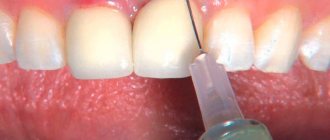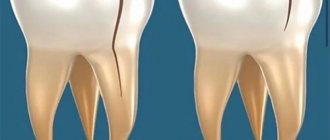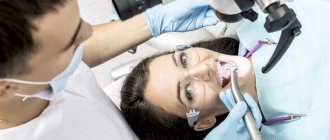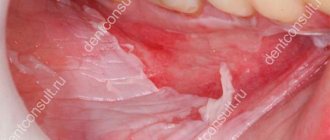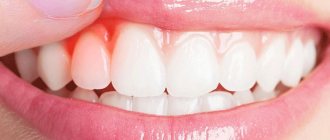Healthy gums contain a healthy tooth
Each tooth is surrounded by soft tissue. They carefully protect its vulnerable spots from bacteria, the mechanical effects of food and acidity surges. The collection of these tissues around each tooth is called the gum.
Let's imagine that:
- The oral cavity is a huge house in which teeth “live”.
- Each tooth has its own “apartment” - the gums.
A person feels better in a well-kept and renovated apartment. Let's make an analogy: teeth need healthy gums.
Let’s figure out what you need to be wary of and what to do if your fears become reality. Let's talk about the health of our gums.
What causes gum pain?
Diseases are classified according to several criteria:
- According to the size of the focus of the disease (local process or large-scale).
- Based on the type of disease, the most convenient classification is:
- Gingivitis;
- Periodontitis;
- Periodontal disease;
- A separate point should be made about microtrauma of the gums and the consequences of other oral diseases (stomatitis, cyst, periodontitis).
Let us consider the etiology and clinical manifestations of each of these pathological conditions.
Gingivitis
This is a disease of the gum margin and interdental papillae. The reason for this is food debris that is not removed from the source of inflammation, rots and provokes the abundant proliferation of opportunistic microorganisms. Typical for adults and children.
The enamel near the gums begins to darken and is covered first with a soft coating, then with hard stone.
The more plaque, the higher the likelihood that the gums will begin to bleed.
With a long process, the gums grow and turn red.
In the photo above: healthy gums, below: the initial stage of gingivitis - tartar
Periodontitis
Untreated gingivitis causes inflammation to spread to nearby tissues. Periodontal and bone tissue suffer.
Over time, the tissue between the tooth and gum is destroyed, leaving the tooth exposed. This is how periodontal pockets form. Pus accumulates in them.
Symptoms: discharge of pus from the pockets, crimson-red mucous membrane, bad breath.
Gingivitis and periodontitis are 2 stages of the same process, starting with plaque and ending with tooth loss. These diseases are not age related.
Before visiting a doctor, we recommend rinsing your mouth with decoctions of chamomile and calendula.
Stages of periodontitis:
Periodontal disease
Attention! In this variant of gum disease, pockets do not form! And gum inflammation does not occur here.
The nature of the disease is dystrophic in nature.
This condition is associated with age and is caused by hardening of the blood vessels that supply the gums. Every year the disease occurs earlier and earlier: today people over 35 years of age suffer from periodontal disease. The process is treatable only in the early stages. At a later stage, it remains possible to control the rate of degeneration. Periodontal disease is associated with systemic diseases of the body (disruption of the endocrine system, atherosclerosis). Its treatment is aimed at ridding a person of systemic diseases and maintaining or restoring blood supply to the gums. For this purpose, nutritional pastes and microbial additives are used. It is necessary to care for the oral mucosa and enamel to avoid inflammatory complications.
Stages of development of periodontal disease:
Stomatitis
This is an inflammation of the oral cavity, localized on the surface of the gums, cheeks, and tongue. Unlike stomatitis and injuries, the rest of the listed diseases are characteristic exclusively of the gums.
There are several types of stomatitis. One of them is typical for older people - this is denture stomatitis. The rest can affect children and adults.
Home treatment for stomatitis is replacement of dentures, antihistamines and rinsing the mouth with antiseptic solutions. For the viral variant, ointments containing acyclovir salts are used.
Features of stomatitis are transparent blisters, in place of which pink sores remain.
Microtraumas and gum cysts
Frequent causes of injury are foreign bodies and wisdom teeth.
The risk group is children who transport into their mouths everything that can fit there.
At the site of microtrauma, a purulent sac may form - a gum cyst.
Wisdom teeth are of particular interest. Their growth is accompanied by high fever and throbbing pain.
You can try rinsing your mouth with antiseptic solutions (chamomile, calendula, chlorophyllite). If you have a cyst, be sure to see your dentist.
Periodontitis
With advanced caries, there is a possibility of infection from the carious canal entering the periodontium. From the periodontium, a microbial agent can rise to the surface of the gums, causing inflammation. If the infection is deep, a cyst or abscess may form on the surface of the gum.
The pain is strictly local in nature. The pain is throbbing. Treatment: local use of antiseptics, systemic antibiotic therapy and surgery.
We do not recommend self-medication.
Signs of Healthy Gums
There are a number of criteria that determine what healthy gums should look like:
- There is no discomfort when carrying out hygiene measures or while eating. If brushing your teeth is accompanied by pain or bleeding gums, this is a signal that you need to see a dentist.
- Color – if the tissues are healthy, the gums have an even, light pink tint. Any redness or bluish discoloration of the mucous membranes indicates the onset of the disease.
- No swelling. Normally, the dental necks are tightly surrounded by gingival tissue, without exposure, but there should also be no swelling.
- No bad breath. Its presence, as well as a constant unpleasant aftertaste, indicate the active activity of harmful bacteria multiplying on plaque.
Photo of healthy gums
What do healthy teeth and gums look like? Externally healthy gums should be pale pink in color, without swelling, redness or sagging that exposes the roots of the teeth.
hygienic teeth cleaning
How modern clinics save gums
The treatment is carried out by a periodontist. It can be found in any dental clinic. We recommend visiting the dentist once a year. Treatment consists of several stages:
- Elimination of the cause of the disease,
- Anti-inflammatory therapy,
- Dental fixation, removal,
- Further prevention.
The cause of inflammation is eliminated by cleaning the oral cavity using various methods.
Previously, doctors practiced the instrumental method of removing plaque. Now – sandblasting and ultrasonic cleaning. These 2 methods are used together. First, stronger ultrasonic cleaning occurs, then cleaning with compressed air moistened with solutions of special salts. In severe cases, it is recommended to carry out procedures once a quarter.
Air Flow Treatment
This is a modern version of sandblasting the oral cavity. Suitable for removing soft plaque. More durable deposits are resistant to this cleaning method. Sodium bicarbonate (baking soda) is used as salt in combination with other substances. The mixture is under enormous pressure, so the output is a powerful stream that dissolves and washes away plaque.
Ultrasonic cleaning of the oral cavity
This is the best method of all time. The principle of the method: dental stone and plaque are destroyed by ultrasound. The nozzle of the device is generously moistened with a stream of antiseptic solution or purified water to wash off the crushed plaque.
Then each tooth is ground with a special attachment.
As an example, let's talk about the drug Vector. This is a German technology for ultrasonic cleaning of plaque. A special feature of the device is the direction of the sound wave along the tooth. With the help of Vector, plaque is removed faster and more efficiently than using non-directional ultrasonic vibrations.
Anti-inflammatory therapy
It consists of using gels and special pastes. The most common method is the complex use of cholisal dental gel (pain relief), an antiseptic solution (chlorhexidine or chlorophyllite), and paste to maintain healthy gums (lacalut, paradontax). It is recommended to use this treatment tactic for 21 days after the procedure.
In the case of gingivitis, treatment ends at this stage.
Be sure to read our article about periodontal mouthguards “New in gum treatment”
Surgical intervention, splinting, prosthetics
In case of periodontitis, further therapeutic measures are required: the patient is prepared for prosthetics or splinting (loose teeth are attached to a healthy dental mass using a splint).
Treatment should be accompanied by taking antibacterial drugs!
Surgical cleaning of periodontal pockets is the main method of treating periodontitis.
The operation is performed under local anesthesia and lasts less than an hour. The most common method of cleaning pockets is the “flap operation.” The gum is cut into flaps, which are sewn back after cleaning. Hence the name of the manipulation.
Modern anesthesia allows invasive interventions to be performed absolutely without pain.
Why you can’t self-medicate
Home treatment – eliminating symptoms! The cause of the disease remains, but the pathological process will remind itself again and again and develop further. It is necessary to eliminate the cause, which cannot be done at home.
Gum diseases
There are a number of infectious and non-infectious lesions in this area, which have various causes and clinical manifestations:
- Gingivitis. Shallow inflammation affecting the marginal areas of the gum tissue. Most often it occurs due to improper oral hygiene, which is why a lot of plaque accumulates on the enamel with harmful microorganisms actively multiplying on it.
Photo of gingivitis
Other prerequisites:
- hypovitaminosis;
- hormonal imbalance (especially in pregnant women and adolescents during puberty);
- diseases of the heart, blood, gastrointestinal tract;
- unsuccessfully placed filling or crown;
- chronic intoxication of the body with compounds of bromine, mercury, lead, bismuth, aluminum.
The following forms are distinguished according to severity:
- catarrhal – mild inflammation, characterized by mild itching and bleeding;
- hypertrophic - this type is characterized by profuse bleeding along with bad breath;
- ulcerative-necrotic - accompanied by the appearance of ulcers, an abundance of grayish plaque, severe pain, and a foul putrid odor.
- Periodontitis is a deeper inflammation of the gums, also affecting its ligamentous apparatus, in especially severe cases reaching the bone tissue. Often occurs as a complication of untreated gingivitis.
Periodontitis in the photo
Other causes of the disease:
- incorrect, traumatic (due to crowding of teeth or other abnormal position) bite;
- severe pathologies of internal organs, immunodeficiencies, diabetes mellitus, blood diseases;
- hypertonicity of the masticatory muscles.
Characteristic symptoms:
- formation of tartar;
- discharge of pus;
- exposure of the necks, loosening, displacement and even loss of teeth;
- severe pain, bleeding;
- When infected, flux may occur.
- Periodontal disease is a non-infectious degenerative lesion of the periodontal tissue, leading to exposure, loosening, and further loss of teeth.
Clinical manifestations:
- discomfort during hygienic cleaning, eating,
- sensitivity of enamel to temperature changes.
Main factors of occurrence:
- age-related changes;
- hypovitaminosis;
- heredity;
- hormonal, vascular disorders;
- smoking, alcoholism;
- chronic pathologies of internal organs.
- Cysts - occur against the background of advanced caries, pulpitis, periodontitis. Injury to the diseased area, hypothermia, and poor hygiene can trigger the development of the disease with the growth of a cyst and the formation of a fistula through which pus is released. In this case, surgical treatment may be required in addition to medication; the components of the latter may be analgesics, antibiotics, drugs that relieve swelling and accelerate tissue regeneration.
Signs of periodontal infection
The following symptoms indicate gum infections:
- soreness and bleeding of gums during hygienic cleaning;
- swelling, redness;
- detachment of gum tissue from the teeth, forming “pockets” in which suppuration may develop;
- constant bad breath;
- loosening of teeth.
Causes of soft tissue diseases in the mouth
In addition to the specific prerequisites that cause the development of a specific disease, general risk factors include living in poor environmental conditions, genetics, chronic pathologies of the body, and lack of proper hygiene. Nutrition plays a decisive role.
In people whose diet is poor in vitamins, microelements, and dietary fiber, but rich in thermally processed foods containing simple carbohydrates (sweets, carbonated drinks, flour), healthy gums are much less likely to be detected.
Impact of bite on gum health
Bite – the location of the upper and lower dental rows relative to each other with the jaws closed. In a healthy person, the upper one should normally protrude slightly forward above the lower one.
The influence of bite on the health of not only the oral cavity, but also other body systems can be traced: incorrect position can increase facial asymmetry and have a negative impact on breathing, hearing, vision, even posture.
Most often, the gastrointestinal tract suffers due to this anomaly (this is caused by poor-quality chewing of food, which leads to disruption of the digestion process). A pathological bite can lead to premature wear and destruction of teeth, which increases the chance of gum inflammation. This problem cannot be treated irresponsibly; in case of any violations, it is necessary to contact an orthodontist to install braces or a mouth guard, and in especially severe cases, to a maxillofacial surgeon.
Preventive measures for gum disease
Remember simple rules for oral health:
- Visit your periodontist (or dental therapist) once a year.
- Brush your teeth twice a day.
- Use dental floss!
- Use special pastes.
- Rinse your mouth after any meal.
- Maintain a healthy lifestyle, watch your diet.
You need to train yourself to take care of your oral cavity from childhood. This habit should become a regular way of your life. Believe me, it is better to follow all the rules than to undergo treatment later!
You need to visit a doctor once a year, at least. In 100% of cases, you will be prescribed a dental cleaning, and this is the only way to remove plaque and tartar. No plaque – no problems with gums.
Oral hygiene is another important point. This includes brushing your teeth. You need to clean it 2 times a day consistently. Select the brush individually - the cleaning process should not cause discomfort. It is better to use soft electric brushes. They thoroughly clean the surface of the enamel and gums.
You cannot clean the interdental space with a brush. So use dental floss. How often – decide for yourself. If food clogs up after every meal, floss every time you eat. If everything is in order, then once every 1-2 days, but clean all the gaps.
If you have large interdental gaps, use simple wooden or special toothpicks.
People with bleeding gums need to use special pastes. The composition of the pastes allows you to speed up the healing of wounds and stop bleeding.
Rinsing your mouth is a good habit. Teach your children to this from early childhood.
Causes of gum inflammation?
After each meal, a small amount of food debris remains on the teeth and between the teeth, which forms a soft plaque. It is difficult to see, but oral microorganisms immediately settle in it. If plaque is not regularly removed from the surface of the tooth, it turns into tartar as a result of the deposition of salivary salts - a substrate for bacterial colonies.
The accumulation of bacterial plaque and waste products of microorganisms in the area of the gingival sulcus leads to gingivitis, subsequently to the destruction of the sulcus, the formation of periodontal pockets, the development of periodontitis and damage to bone tissue. Inflammation of the gums develops faster when the general defenses of the body are weakened, with dental caries, after a tooth injury (for example, with a blow, microtrauma when biting a thread), after unsuccessful prosthetics.
Diseases such as hypertension, diabetes, diseases of the thyroid gland and adrenal glands lead to serious changes in the entire body, including the periodontium. Patients with this pathology should be under constant supervision of a periodontist and therapist. Regular visits to these specialists allow you to successfully treat gum inflammation and save teeth in the presence of general diseases of the body.
Plaque, which is the main cause of gum disease, contains a huge variety of bacteria that can spread to other organs. In this regard, periodontal pockets are centers of chronic infection. It has been proven that the long-term presence of infection in such a formation leads to the development of rheumatoid arthritis, infective endocarditis, gastritis and enterocolitis.
We will answer your questions
I experience pain when I brush my teeth, and blood flows from my gums. What could it be?
Contact a periodontist. You have gum disease caused by poor oral hygiene (or gingivitis).
How can you tell if your gums are unhealthy?
Pay attention to the color of the gums, bleeding, pain when brushing and the size of the visible part of the tooth, the presence of plaque. These are the main criteria in this case.
Does smoking affect your gums?
Yes, tobacco smoke negatively affects the color of teeth and destroys enamel. Accordingly, the gums will also suffer.
Can I die from periodontitis?
Theoretically yes. You can die, for example, from sepsis or from infection entering the brain. In practice, in the modern world, this is very difficult to achieve, only if you wait until the disease goes away on its own.
I'm pregnant, is gum disease dangerous for me and my baby?
Yes, in your case there may be a miscarriage or premature birth. Remember that a chronic source of infection in your body is a threat to the child. A microbial agent can enter the fetus’s body and cause irreversible processes. There is also a danger to your teeth. During pregnancy, the mother's bone tissue is very vulnerable.
Is this even curable?
Gum disease can almost always be cured. The only question is how many teeth you will have left by then. Joke. But, if the disease starts, the loss of some teeth is inevitable.
How much does gum prevention cost?
The ultrasonic cleaning procedure costs from 5 to 15 thousand rubles per procedure.
If I take care of my gums, what is the likelihood that they will always be healthy?
Probability 99%
Are there any contraindications for dental implantation?
There are several contraindications: osteoporosis (which has not been treated), diabetes and smoking. The implant may not take root.
My mother has periodontitis. Will I suffer from this too?
Gum disease is not inherited.
Once a year, the gums around the wisdom teeth become very painful and swollen, what should I do?
When there is another inflammation, contact your dentist. There is a high probability of surgical intervention. Use Cholisal when pain worsens.
How to care for your gums
Gum care is an integral part of personal hygiene to maintain oral and dental health.
The gum is a mucous membrane that covers the neck of the tooth, the alveolar processes of the upper and lower jaws and is part of the periodontium - a complex of tissues that surround the teeth and hold them in bone tissue. This is a single system and damage to one element affects the function of the entire dentofacial apparatus.
Healthy gums have the following signs:
- Pale pink color.
- Moderately damp.
- No redness, cyanosis or rash.
- No discomfort when brushing your teeth.
- No swelling, enlarged gingival papillae, bleeding or unpleasant odor.
Lack of hygienic gum care can lead to the development of various diseases, for example, gingivitis, periodontitis, dental caries, and gum recession.
How to understand that you have sore gums?
You should contact your dentist if you have the following symptoms:
- Redness or blueness of the gums.
- Bleeding and swelling.
- Pain when brushing teeth.
- Bad breath.
- If there is visible plaque and tartar that cannot be removed with a toothbrush.
What affects the condition of the gums?
- The first and main point is poor oral hygiene.
- The first and main point is poor oral hygiene and dental plaque, which is a good condition for the proliferation of microorganisms, the waste products of which have a damaging effect.
- Incorrectly selected personal hygiene products that do not provide adequate plaque removal or injure the gums.
- Bad habits (smoking, alcohol abuse, rough, sour, spicy foods, etc.) also have a negative effect on gum tissue.
- Incorrect technique of brushing teeth and using interdental hygiene products.
- — Presence of somatic diseases (diabetes mellitus, thyroid disease, hormonal imbalance, vascular disorders, etc.), taking certain medications.
- Chronic trauma to the gums (for example, the edge of a prosthesis or crown, overhanging edges of fillings, etc.), which can lead to various inflammatory processes.
- The presence of carious cavities, which are an excellent place for the accumulation of food debris and microorganisms, which can also affect the gums.
- Pathology of the bite (for example, crowding makes it difficult to carry out hygienic manipulations; various pathologies of the bite can lead to uneven distribution of the chewing load, which can also negatively affect the gum and periodontal tissues in general).
The key to healthy gums is to follow certain rules of care:
- Regular preventive examinations at the dentist
- Professional hygiene every 6-12 months, and if you have braces, every 3 months
- Adequate personal hygiene products, selected individually, as well as their regular replacement
- High-quality, regular and proper teeth cleaning at home
- Using an irrigator improves blood circulation in gum tissue and helps prevent diseases
- Compliance with doctor’s recommendations and prescriptions during medical and surgical procedures
- Monitoring the general condition of the body (proper nutrition, avoiding bad habits, treatment of somatic diseases)
- Timely sanitation of the oral cavity (dental treatment, replacement of defective fillings and orthopedic structures)
How to care for your gums after tooth extraction?
Tooth extraction is a surgical procedure, therefore, to prevent complications, it is necessary to follow some recommendations that the doctor voices after the operation. For rapid healing, the formation of a blood clot in the socket of the extracted tooth is necessary, so in the first 2-3 hours after extraction it is necessary to refrain from eating and drinking so that it can form.
For the first time, you need to avoid rough, spicy, hot foods for 2-3 days; this can injure the gums. You should also not rinse your mouth so as not to wash out the blood clot, but you must do mouth baths with an antiseptic prescribed by your doctor.
In the period after tooth extraction, careful, but careful and gentle hygiene is necessary. You should also brush your teeth 2 times a day with a small amount of toothpaste, gently cleaning the area of the extracted tooth. To do this, you can use special toothbrushes that are designed for oral care after surgical procedures and special toothpastes and rinses containing antiseptic components and promoting tissue regeneration after surgical interventions.
The attending physician will select the necessary hygiene products based on your clinical situation.
How to care for gums with sutures?
Sutures are placed after various surgical procedures (tooth extraction, implantation, plastic surgery of gum recession). In general, care recommendations are the same as for tooth extraction. but the doctor always gives individual recommendations. It is important to remember that during this time it is necessary to avoid heavy physical activity and sudden facial movements, as this can cause the seams to separate.
When performing gum recession surgery, at first you should not clean the surgical area with a toothbrush for about 2 weeks, then use a surgical brush, and you should not use floss or irrigator for a month. And most importantly, it is important to follow all the doctor’s recommendations!
How to care for your gums after a gum former is installed?
A gum former is a device that is installed after implantation or some time later to form the bed of the future crown in order to ensure the most physiological attachment of soft tissue in the area of the future structure.
This area should also be carefully cleaned with a soft or surgical toothbrush, antiseptic rinses prescribed by your doctor should be performed, and rough, hot foods that can injure the gums should be avoided.
How to care for your gums after a sinus lift?
Sinus lifting is a procedure to restore the lost height of the upper jaw bones by reducing the volume of the maxillary sinus and filling the resulting space with a bone tissue substitute. This operation will allow you to install implants if the natural height of the jaw bone is not enough to securely attach them.
After this operation, for hygienic care of the gums, it is necessary to carefully brush your teeth with a surgical brush, take antiseptic baths, and after each meal, carefully rinse your mouth with a special rinse. Also exclude physical activity, thermal procedures (baths, saunas), rough hot foods.
To summarize, taking care of your oral health requires daily gum care. After all, the health of the teeth and the entire dental apparatus largely depends on the condition of the gums.
Take care of yourself and smile more often!
